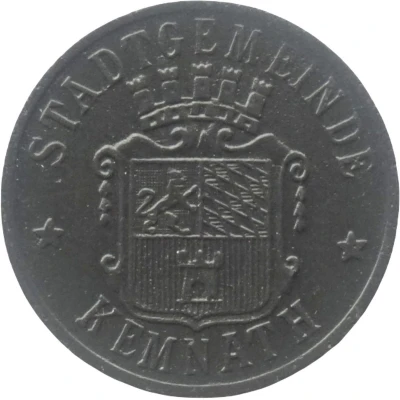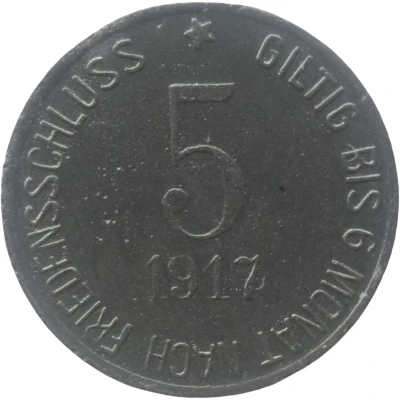


© Willem63 (CC BY-NC-SA)
5 Pfennigs - Kemnath
1917 year| Zinc | 1.4 g | 18.0 mm |
| Issuer | City of Kemnath (Federal state of Bavaria) |
|---|---|
| Emperor | William II (Wilhelm II) (1888-1918) |
| Type | Standard circulation coin |
| Year | 1917 |
| Value | 5 Pfennigs (5 Pfennige) (0.05) |
| Currency | Mark (1914-1924) |
| Composition | Zinc |
| Weight | 1.4 g |
| Diameter | 18.0 mm |
| Thickness | 0.9 mm |
| Shape | Round |
| Technique | Milled |
| Orientation | Medal alignment ↑↑ |
| Demonetized | Yes |
| Updated | 2024-10-04 |
| Numista | N#30591 |
|---|---|
| Rarity index | 92% |
Reverse
Pearl rim, legend surrounding denomination and date centered
Script: Latin
Lettering:
★ GILTIG BIS 6 MONAT NACH FRIEDENSSCHLUSS
5
1917
Edge
Plain
Comment
Issuing body: [Stadt, Bayern].Interesting fact
The 5 Pfennigs - Kemnath 1917 coin from the City of Kemnath in Bavaria, Germany, is interesting because it was made of zinc, a material that was commonly used for coinage during World War I due to its low cost and durability. This coin was issued during a time when many countries were experiencing metal shortages, and zinc was seen as a suitable alternative to traditional metals like copper and silver. The use of zinc in coinage during this period helped to preserve the production of coins and ensure the continued circulation of currency during a time of economic and political upheaval.